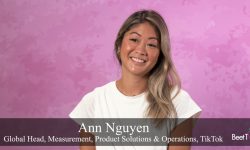Disney Advertising aims to provide marketers with more insights about audience engagement on its video streaming platforms as part of an expanded agreement with measurement company EDO.
The companies on Thursday announced a deal to apply EDO’s metrics to Disney’s streaming services, first with Hulu. Measuring outcomes gives advertisers a better idea of how consumers reacted to television campaigns.
“It’s a big move by Disney, who arguably is the 800-pound gorilla in streaming and ad-supported streaming, given that it owns Disney+, Hulu and ESPN+ among its incredible content library,” Kevin Krim, chief executive of EDO, said in this interview with Beet.TV.
“For Disney to say that ‘we’re making a commitment to outcome measurement’ as part of their upfront strategy, as part of their ongoing advertising strategy — we think it’s a real bellwether of where this whole industry is going,” Krim said.
Disney has used EDO to measure outcomes for tentpole events and live sports like The Academy Awards, American Music Awards, ESPN’s Monday Night Football and college football playoff games.
“Through our expanded relationship with EDO, we are bringing insights to brands based on the largest and most leaned-in audiences in live sports and events to show the impact of an ad exposure in streaming on cross-screen digital behavior like search and site visits,” Danielle Brown, senior vice president of data enablement and category strategy for Disney Advertising, said in a statement.
Disney Advertising and EDO announced their new collaboration during Disney’s Tech and Data Showcase, a virtual event that highlights the media giant’s data clean room initiative, platform technology, programmatic capability and measurement solutions. The showcase is part of Disney’s upfront sales presentations to marketers and media buyers.
“Our partners at Disney have said publicly that over a third of the live usage for Monday Night Football across all of their screens was on the ESPN+ app,” Krim said. “They have great consumer data about those people because they are subscribers, and that means they’re able to both serve them national ads, but also locally targeted ads as well. That’s just one example of how I think differently you’re going to see this upfront season unfold.”
Disney’s Audience Graph and Clean Room Technology
Disney Advertising also said most major agency and media holding companies including Dentsu, Horizon, IPG Mediabrands, Omnicom Media Group and Publicis Media, along with about 75 advertisers, had adopted its clean room offering. Data clean rooms (DCRs) offer advertisers and media companies a way to match their different groups of consumer data while protecting people’s privacy.
“For Disney, privacy is a feature – not an afterthought, and we’re committed to creating solutions on the cutting edge of responsible data collaboration,” Dana McGraw, senior vice president of audience modeling and data science at Disney Advertising, said in a statement. “For more than a decade, we anticipated the need for a holistic, cross-screen view of consumption across our properties, which formed the foundation of Disney’s first-party Audience Graph.”
Future of First-Party Measurement
Disney said it is building on a multi-year relationship with Samba TV to determine true reach and frequency across all screens.
“Disney continues to lead the industry in the use of TV data to enable a far more insights-driven future for measurement,” Ashwin Navin, founder and CEO of Samba TV, said in a statement. “Our collaboration with Disney continues to future-proof advertising for the next generation multi-currency world, empowering advertisers to measure their effectiveness on any Disney platform, across every screen.”
Samba TV this month announced agreements with partner companies MiQ and TCL that will help to advance its goal of providing comprehensive insights and audience analytics.
Unilever Tests Disney’s Automation Platform
Unilever, the consumer packaged goods giant whose brands include Dove soap and Hellman’s mayonnaise, is the first company to test the integration of Disney’s audience graph and the open-source identity framework Unified ID 2.0 developed by The Trade Desk. Unilever collaborated with Mindshare on the test.
“We are excited to be on the front lines of this future-fit partnership between Disney and The Trade Desk, so we can continue learning about holistic reach and frequency in a privacy-safe environment,” Aaron Sobol, head of media investment and partnerships at Unilever, said in a statement.
By creating an audience match from high-fidelity first-party data instead of more traditional means of matching based on cookies or pixels, advertisers can see if they reached a key audience, while simultaneously achieving scale to increase incremental reach across linear, CTV and digital channels.
The next phase of Disney’s addressable advertising innovation is at the intersection of identity and interoperability. Its audience graph, built with a privacy-first approach primed for data collaboration, provides speed-to-market without any movement of first-party data, according to the company.














































